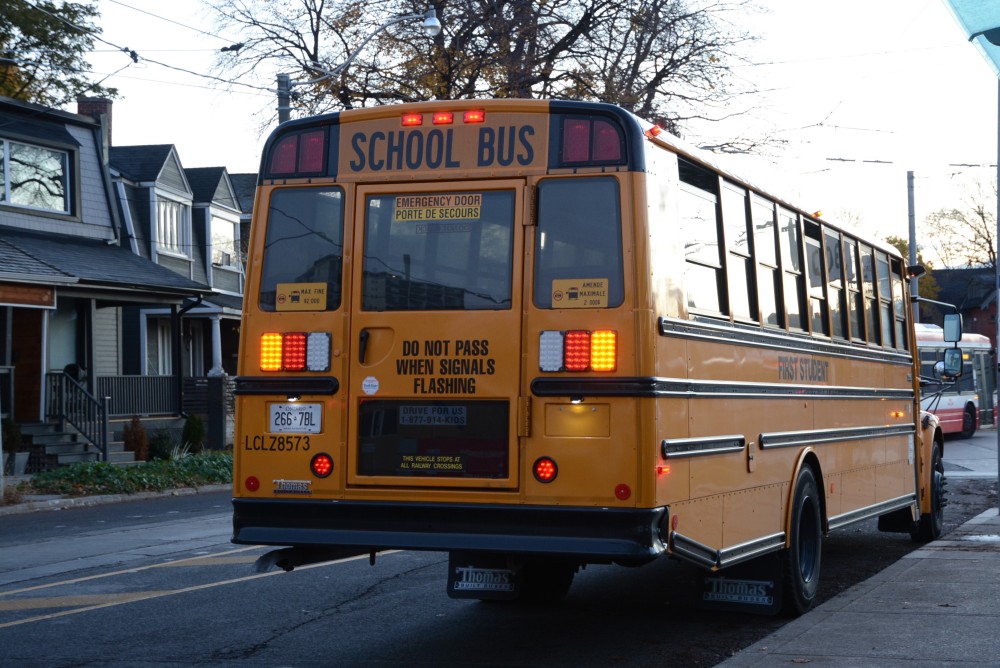September marks the start of a new school year for kids across Ontario, and for 833,000 of them — about 40 per cent of all students — that means boarding the iconic yellow school bus. While 18,000 drivers work hard to get students to class, those buses are spewing diesel fumes that harm our children’s health. It’s time to give our kids a healthier ride by committing to accelerating the transition to electric school buses.
Exhaust from diesel-powered school buses are well-established carcinogens, emitting harmful pollutants such as benzene, sulfur dioxide, fine particulate matter and over 40 toxic air contaminants. There is no safe level of exposure to diesel exhaust, especially for children, whose developing lungs are particularly vulnerable. Prolonged exposure to diesel exhaust increases the risks of cancer, asthma and other adverse respiratory and cardiovascular health issues.
Researchers in the United States found that replacing a single diesel bus with an electric one in a large city could result in US$207,200 in health benefits, from reduced rates of childhood mortality and asthma. In 2022, research from Ecology Ottawa found that lower socioeconomic groups, in particular, face increased health risks due to higher exposure to emissions.
Fortunately, solutions are available. Electric school buses emit no pollutants and pose no health risks to children. A study by the Michigan School of Public Health found that switching to cleaner fuels and technologies resulted in students being up to 10 per cent less likely to miss school, with children suffering from severe asthma experiencing 15 to 20 per cent fewer absences. Our children deserve to start — and end — their day in a pollution-free environment.
Electric school buses also offer significant economic and environmental benefits. The electric bus market is projected to reach US$3.1 billion in global annual sales in the next five years, with the North American market set to double in the next two to three years. According to a study by the Pembina Institute, electrifying 65 per cent of Ontario’s school bus fleet could boost the Ontario auto manufacturing sector, generating more than 13,000 jobs and nearly $2 billion in economic output, all while cutting emissions by approximately 234,000 tons of CO2 every year.
There are certainly challenges to this transition. Electric school buses may not be appropriate or possible in every scenario, particularly in rural areas where long distances are common. Cold weather can also present issues for battery performance. Additionally, the higher upfront costs of electric buses are a significant hurdle for transportation consortia that already face funding constraints, even for diesel buses.
These challenges are surmountable. Many school buses travel in urban and suburban areas with relatively short distances, engage in energy-efficient low-speed operations and have long downtimes in depots where they can easily charge. These make them prime candidates for electrification. A white paper by Pollution Probe, the Canadian Partnership for Children’s Health and Environment and Delphi demonstrates the health benefits of electric school buses and their practicality for many school districts. Research by these organizations has also noted the importance of electric school buses in providing “active hope” to children — the knowledge that they are actively contributing to help solve the climate challenge.
Government action is essential to accelerate this transition. First, the Government of Ontario should set a clear goal for the electrification of school buses and develop a strategy to meet that goal. For example, neighbouring Quebec and Prince Edward Island have set a goal to electrify 65 per cent of their school bus fleet by 2030. The Ministry of Education, which funds school bus operations, can support investments in electric buses and infrastructure through funding support and greater contractual certainty. Funding models should also be revised to cover more upfront costs while reducing fuel payments over the lifecycle of a vehicle.
We should not be content with the status quo — polluting diesel buses that impair our children’s health. With public support, we can push for the policy changes needed to accelerate the transition to electric school buses.
Hongyu Xiao is a senior analyst with the Pembina Institute's transportation team.
Cedric Smith is the director of transportation with Pollution Probe, a Canadian environmental non-profit.
Dan Rutabingwa Gakire is the climate program coordinator at Ecology Ottawa in Ottawa, Ontario, Canada.







